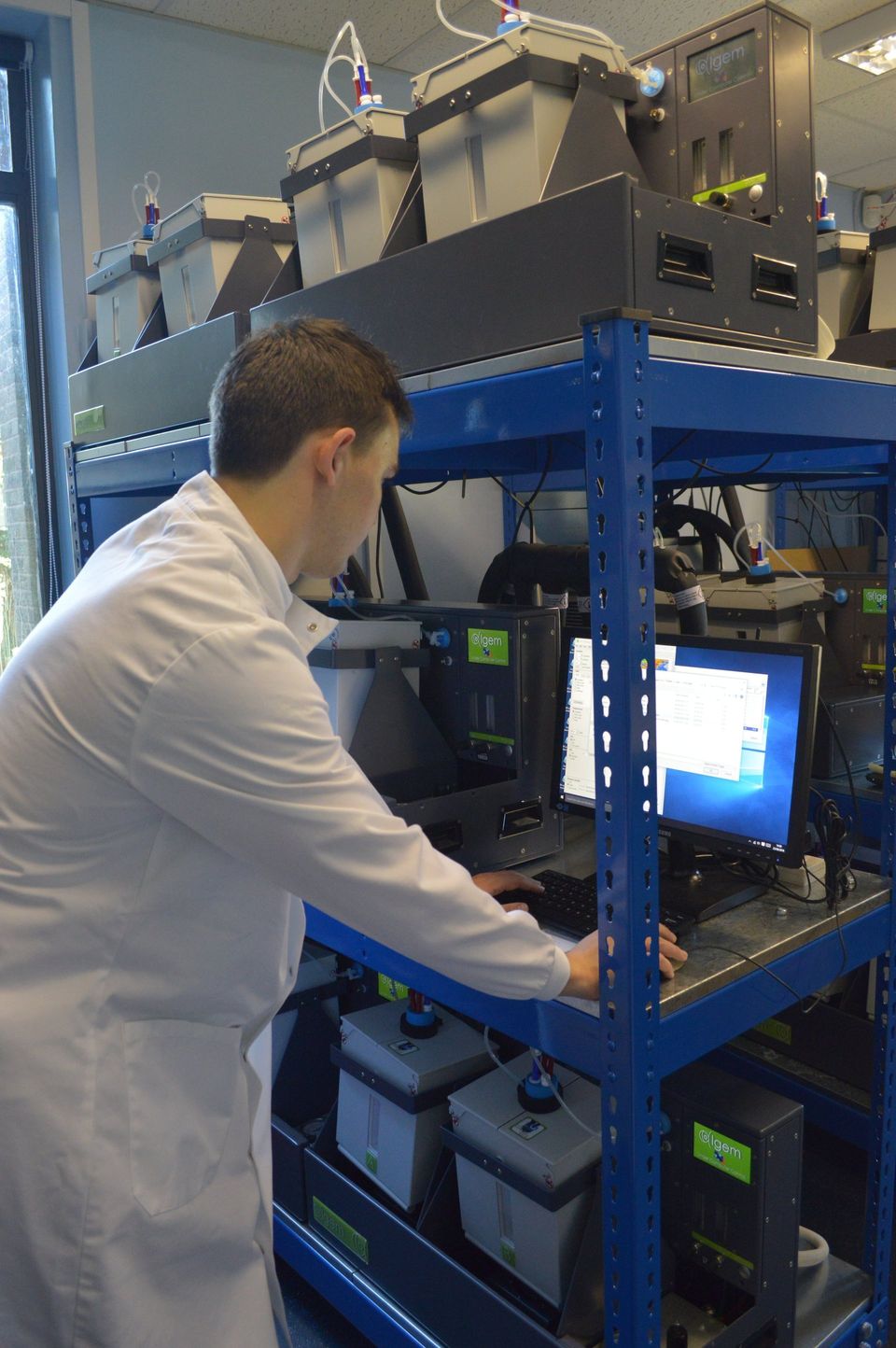Interview with Tom Butler, Algenuity intern
algenuity • July 19, 2016
On Tom's last day, Mike Yates sits down with Tom Butler to chat about his Algenuity internship experience
Tom Butler is finishing up a 9 month internship with Algenuity and will be headed to the University of Sheffield this autumn to start his Ph.D. under the supervision of Dr Raman Vaidyanathan. Mike Yates, our Head of Business Development at Algenuity, sat down with Tom to chat about his experience at Algenuity.
You have had a long-standing interest in the environment and marine studies. Can you share a little bit more?
I have always loved the ocean and marine life. For my undergraduate degree, I followed this passion and studied Marine Biology at Newcastle University. And outside the lab, I have been an avid scuba diver. Earlier this year, I travelled to Sri Lanka to go on a dive trip, and in two weeks, I am going out for a dive trip to Malta!
Brilliant. So how did you get into algae?
Learning from and working with Gary Caldwell at Newcastle really opened me up to the positive potential for algae for real world issues and how algae can provide sustainable solutions to energy and food challenges. At Newcastle, we conducted several practicals on micro- and macroalgae. This motivated me to apply to SAMS (Scottish Association for Marine Science) for their MRes programme in Algal Biotechnology.
How was the experience at SAMS? Would you recommend the programme?
I thoroughly enjoyed the masters year at SAMS. I deepened my microbiology knowledge, expanded my toolset, and developed my algal research skills. I did my dissertation on "An alternative strategy for astaxanthin production using Haematococcus pluvialis ".
Yes, I would definitely recommend the SAMS Algal Biotechnology MRes programme. It provided me with a solid foundation for this year’s industrial internship and will prove to be invaluable for my future Ph.D. studies. It was also great to be mentored by leading algal biologists, such as Professor John Day and Dr Michele Stanley. I also really loved being in the SAMS location of Oban, Scotland. It is so beautiful there, and it is great for adventure enthusiasts.
What has been some of the highlights of your Algenuity internship?
I have enjoyed working with the extremely talented scientists and the multidisciplinary team here at Algenuity and Spicer Consulting. It is such a dynamic and innovative environment.
It has been particularly great to be specifically mentored by Michiel Matthijs, the CSO of Algenuity. I have learned a lot about rigorous experimental design, analysis of data, and drawing conclusions for the purpose of either future papers or patents. Michiel has also taught me how to use some of the key equipment in the labs, including the liquid handling robot and the 384-well qPCR machine. It has been a lot of fun.
Any other highlights?
I enjoyed growing my algal molecular biology skills and learning about genetic manipulation of algae. Algenuity is the perfect place to learn about this. I worked mostly with Phaeodactylum tricornutum and developed and worked with tags, such as the uracil 3 marker and the halo tag.
I also have enjoyed producing the Algem application notes. It has been great to work with a large variety of algae and optimise growth conditions for the algae. I particularly enjoyed working with extremophilic species of algae, such as the acidophile and thermophile, Galdieria sulphuraria
; the alkaliphile, Arthrospira platensis ; and the psychrophile, Fragilariopsis cylindrus .
Did you have a particular favourite application note?
My favourite application note was studying the locally bioprospected Haematococcus pluvialis
strain. As I mentioned earlier, I did my dissertation on Haematococcus pluvialis
.
What made this application note particularly interesting was that one of the constraints of industrially produced astaxanthin is the temperature range. Optimal growth for normal Haematococcus pluvialis
strains is usually between 20 to 25 degrees Celsius. If the temperature is higher, cells in the green stage transition to cysts/aplanospores, and this limits biomass yields and flexibility.
At Algenuity, we have isolated a Haematococcus pluvialis
strain that thrives at 30 degrees Celsius and remains in the green stage without the induction of aplanospores. This increased temperature range has positive industrial implications. Overall, it shows the power and potential of bioprospecting.
A bit of a geeky algae question – is Haematococcus pluvialis
your favourite alga? Mine is Euglena gracilis
.
Actually, my favourite alga is the diatom Phaeodactylum tricornutum
. I am actually going to be studying Phaeo for my upcoming Ph.D. at Sheffield.
I love how Phaeo
has a fast growth rate and is less sensitive to contamination than other microalgae. It is like a weed and just grows and grows! I also appreciate that the genome has been sequenced, that the molecular toolbox continues to develop and improve, and that there are transformation approaches available.
With your extensive work with the Algem application notes, it is fair to say that you have used the Algems more than any previous intern we have had at Algenuity. What particularly do you like about the Algem?
The tightness of errors bars for growth and environmental parameters such as temperature, light, and pH is hands down the best thing about the Algem.
Coming from a marine background, I have found it really useful to monitor and control the pH level at a set pH range or pH level. For example, seawater often has a set pH, and it is very useful to simulate conditions in the alga’s native environment. I also appreciate the geographical modelling feature of the Algem where you can pretty much model any daylight and temperature profile from around the world by inputting a longitude and latitude value. From an ecological point of view, it is powerful to be able to study the organism under environmental parameters close to its true environment, including cloud cover!
I have also valued how you can sample simultaneously over a planned time course while the Algem is running through a sterile syringe and vacuum manifold system. Michiel and I did an extensive qPCR experiment investigating circadian rhythms and the disruption of these systems using Phaeodactylum tricornutum
using this technique.
Out of curiosity, did you use any particular geographical regions in any of your Algem experiments?
I did an experiment with Chlorococcum novae-angliae
modelled in its place of origin in the California, USA area. I also studied Desmodesmus abundans
and Desmodesmus subspicatus
modelled in different locations of India and China to look for areas with low labour and land costs and locations that could be useful for bioremediation.
You are headed up to the University of Sheffield this autumn to begin your Ph.D. in the lab of Dr Raman Vaidyanathan. Can you share what you will be studying?
I will be studying Phaeodactylum tricornutum
as an aquaculture feedstock to replace fishmeal that is used in the process. The emphasis will be on optimising protein, fatty acids, and carotenoids. I have a particular interest in EPA and fucoxanthin. I will be looking at both non-GM and GM tools. I am very excited to get started at Sheffield!
As a closing question, what advice would you give to students who are interested in algae?
The microalgae sector is multidisciplinary, and it needs skills from many fields including molecular biology, engineering, ecology, biochemistry, and business. You can be involved!
As far as practical tips, when pursuing a new project or idea, make sure to do background reading. It is so important.
As far as the algae industry, the limit to success is the economics. The economics should always be in the back of your mind when doing research.
Because the field of algae research can be so broad, I find it helpful to keep a focused approach. I like to try to see things through a problem-solution lens. I try to make sure I define a problem when beginning a project. It makes pursuing a solution much easier!
And lastly, look out for good mentors. I have been so fortunate to have great mentors, such as Gary Caldwell, John Day, Michele Stanley, and Michiel Matthijs. They have been pivotal in helping me to grow professionally and helped to accelerate my career.
Thanks again Tom for your time and for being willing to do this. You have been a valuable member of our team, and we will miss you. We wish you the best at Sheffield!



